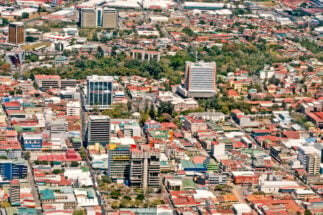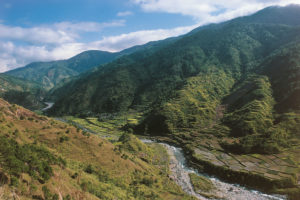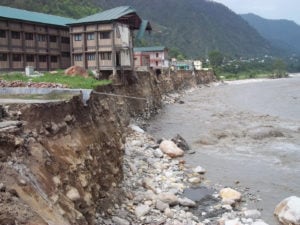The flash flood which claimed dozens of lives and destroyed hydropower projects and bridges in the north Indian state of Uttarakhand on February 6 has reignited concerns about the proliferation of hydropower in the region at large. Jammu and Kashmir, with its 11.3 gigawatts of potential hydropower capacity identified in the Chenab valley, is particularly at risk.
In the wake of the Uttarakhand flood disaster, Scientific American quoted Fabian Walter, a glaciologist at the Swiss Federal Institute of Technology in Zurich, as saying that disasters in the Himalayas have always happened, “but we believe that climate change will make [them] worse,” and the effects of “a warming climate are making it even harder to assess what hazards lurk in amidst the icy peaks.” A study in June 2019 on acceleration of ice-melting in Himalayas revealed that local glaciers are melting twice as fast in the 21st century as they were from 1975 to 2000 – this, the study says, has disrupted the glaciers which were once sturdily frozen in place.
Like in other parts of the Himalayan region such as Sikkim and Himachal Pradesh, the destructive flood has brought into sharp focus the tension between development ambitions and the fragile ecosystem of Jammu and Kashmir, which is undergoing rapid changes due to climate change. According to the Jammu and Kashmir government, out of the estimated hydropower potential of 20 gigawatts in the region, about 16.5 gigawatts have been identified, but only 3.26 gigawatts, under 20% of the total, has been exploited so far. This suggests that if the government goes through with its plans, there could be much more hydropower developed in the region.
When it comes to transboundary rivers, hydropower development can also exacerbate geopolitical tensions. On January 20, the Indian Prime Minister, Narendra Modi, gave approval for the investment of INR 52.82 billion (USD 724 million) for the construction of 850 megawatt Ratle Hydro Electric Project (HEP) located on the river Chenab. The plan was greenlighted despite the Pakistani government’s objections that it was not in conformity with the Indus Water Treaty, which regulates access and rights over shared waters between the two countries. Weeks earlier, another hydropower project was approved for construction in Jammu’s Kathua district. Over 214,000 trees are to be felled and 680 hectares of forest land are to be diverted for the construction of a 116 metres high dam.
![View of Pul Doda from the road above, a half submerged structures of a mosque, a temple and a few houses can be seen [image by: Majod Maqbool]](https://dialogue.earth/content/uploads/2017/10/A-view-of-the-Pul-Doda-area-from-the-road-above.-The-half-submerged-structures-of-a-mosque-a-temple-and-a-few-houses-can-be-seen-here..jpg)
Rao Farman Ali, who writes on water issues and is the author of a book on water policy in Kashmir, said that the region’s entire hydropower policy, including environmental impacts assessments, should be updated in light of political and environmental changes, as well as technological advancement.
“We live in an era where disasters can strike us with much more frequency because of the impacts of climate change,” Ali told The Third Pole. “Wrong actions carried out in one region can have devastating impact in another region especially when we talk of flooding disasters,” he added.
Faiz Bakshi, a Srinagar-based environmental activist, said that the massive disaster in Uttarakhand was bound to happen given the continued widespread ecological damage caused by ill-conceived projects despite warnings from environmental activists. “Jammu and Kashmir too is treading on a similar path in the name of development with deforestation, mining and tunnelling of the mountains for dams and highways destroying the fragile ecology,” Bakshi said.
“Be ready for such disasters in Jammu Kashmir if we continue to blast mountains, build big dams, cut down trees in the thousands every year in the name of so-called development,” said Raja Muzaffar Bhat, an environment and Right to Information campaigner in Kashmir.
“Construction of big hydropower projects is not only a threat to the environment, leading to the felling of hundreds of thousands of trees, but to human life as well,” Bhat said. “These arbitrary decisions not only violate laws, but go completely against the Sustainable Development Goals, as the policy adopted by the government is unnatural and unsustainable,” he added.
Need for review?
Iftikhar Drabu, a Kashmiri engineer and researcher with over three decades of experience in hydropower projects and civil infrastructure, said that the concerns about massive hydropower construction in Chenab valley need to be taken seriously and their impact studied properly.
“One thing is established, large dams induce seismic activity, and we have a few large ones planned on Chenab including Sawalkote which is 185 metres high,” he told The Third Pole. “The geology of the Himalayas is fragile and leads to these problems. And it is not only hydro projects, but any activity which affects the stability of the area,” he said. “The most common are the Srinagar-Jammu highway blockages because of slips in Ramban area.”
While responding to the concerns expressed by some environmentalists, Shakil Romshoo, Dean of Research and Department Head at the Earth Sciences department of Kashmir University, said that there are quite a few glacial lakes in Chenab and Zanskar regions which have the potential to burst and cause damage downstream.
In an interview, he said that “the number and size of these lakes has shown an increase over the time due to the enhanced melting of the glaciers in the Himalayas under the changing climate,” adding that about 15 of these glacial lakes, particularly in the Ladakh, Korakoram and Chenab regions are vulnerable to outburst and the consequent flooding. He also noted that the risks of a glacial lake bursting should be taken into account in order to design safer hydropower infrastructure and protect the downstream communities of the Chenab valley.
But Jigmet Takpa, Joint Secretary at India’s Ministry of Environment, Forests & Climate Change, said that rather than putting the onus on the government “all of us together need to develop adaptive strategies to avoid damages.” For example, he said, not building houses near or on river-beds.
![<p>The Baglihar dam in Jammu & Kashmir [image: Draskd]</p>](https://dialogue.earth/content/uploads/2020/07/Baglihar-dam-300x200.jpg)








